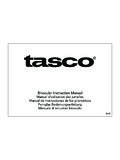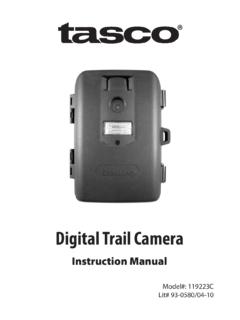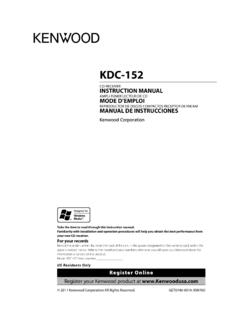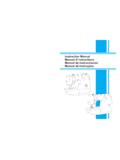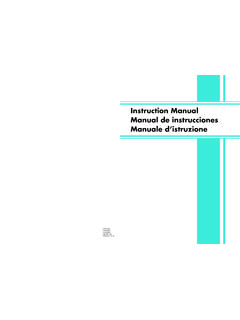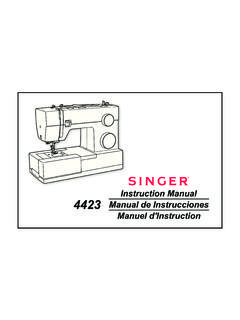Transcription of INSTRUCTION MANUAL • MANUEL …
1 LIT.#: 9303350505 INSTRUCTION MANUAL MANUEL D INSTRUCTIONSMANUAL DE instrucciones BEDIENUNGSANLEITUNGMANUALE DI istruzioni MANUAL DE INSTRU ES 16/1/05 10:58:03 AMCONTENTSENGLISH .. 2 FRAN AIS ..35 ESPA OL ..69 DEUTSCH ..103 ITALIANO ..137 PORTUGU S ..171 26/1/05 10:58:03 AMWHERE DO I START? LOOK DIRECTLY AT THE SUN WITH YOUR TELESCOPE PERMANENT DAMAGE TO YOUR EYES MAY OCCUR Your Tasco telescope can bring the wonders of the universe to your eye. While this MANUAL is intended to assist you in the set-up and basic use of this instrument, it does not cover everything you might like to know about astronomy.
2 Although SpaceStation will give a respectable tour of the night sky, it is recommended you get a very simple star chart and a flashlight with a red bulb or red cellophane over the end. For objects other than stars and constellations, a basic guide to astronomy is a must. Some recommended sources appear on our website at Also on our website will be current events in the sky for suggested viewing. But, some of the standbys that you can see are:The Moon a wonderful view of our lunar neighbor can be enjoyed with any magnification.
3 Try viewing at different phases of the moon. Lunar highlands, lunar maria (lowlands called seas for their dark coloration), craters, ridges and mountains will astound you. Saturn even at the lowest power you should be able to see Saturn s rings and moons. This is one of the most satisfying objects in the sky to see simply because it looks like it does in pictures. Imagine seeing what you ve seen in textbooks or NASA images from your backyard!Jupiter the largest planet in our solar system is spectacular. Most noted features are its dark stripes or bands both above and below its equator.
4 These are the north and south equatorial belts. Also interesting are Jupiter s four major moons. Pay close attention to their positions from night to night. They appear to be lined up on either side of The Great Red Planet appears as a reddish-orange disk. Look at different times of the year and try to catch a glimpse of the white polar ice just like the moon, Venus changes phases from month to month. At times Venus appears brilliantly in the night sky, just as if you were looking at a distant crescent The Great Orion Nebula is a very well known night sky object.
5 This and many others are brought to you by this Clusters View millions of stars densely packed in a cluster that resembles a ball. Galaxies One of the greatest and most interesting galaxies is our neighbor the Andromeda Galaxy. Enjoy this and many on the purchase of your Tasco SpaceStation Goto Telescope! It is our sincere hope that you will enjoy this telescope for years to come! 3-46/1/05 10:58:04 AM Adjustable Aluminum Tripod Assembly (Pre-assembled to SpaceStation Computerized Star Locator Base) Quick Release Accessory Tray SpaceStation Telescope with finger attachment nuts Red Dot Finderscope 2 Eyepieces Barlow Lens (Reflectors Only) PARTS LIST QUICK ASSEMBLY 1.
6 Red Dot Finderscope 2. " Format Eyepiece 3. Rack and Pinion Focusing Mechanism 4. Accessory Tray Brace 5. Quick-Release Tripod Leg Lever6. Quick-Release Accessory Tray 7. Remote Computer Controller8. Main Telescope Tube 9. Quick-Release Adjustable Aluminum TripodTELESCOPE PARTS 5-66/1/05 10:58:07 AMMALIGNING FINDERSCOPELook through Main Telescope Tube and establish a well-defined target. (see Focusing Telescope section)Remove plastic insulator from between Red Dot Finderscope battery and battery Red Dot Finderscope through Red Dot Finderscope, turn adjustment wheels until the red dot is precisely centered on the same object already centered in Main Telescope Tube s field of , objects located first with the Red Dot Finderscope will be centered in the field of view of the main telescope.
7 MFOCUSING TELESCOPE1. After selecting the desired eyepiece, aim main telescope tube at a land-based target at least 200 yards away ( a telephone pole or building). 2. Fully extend Focusing Tube by turning Rack and Pinion Focusing While looking through selected eyepiece (in this case the 20 mm), slowly retract Focusing Tube by turning Rack and Pinion Focusing Mechanism until object comes into ASSEMBLY (CONTINUED) ASSEMBLYNo tools are required for assembly of your telescope. Remove all components from the carton and identify all components.
8 It is a good idea to lay all the parts out in front of you before assembly. Since your telescope is a precision optical system the parts require careful handling particularly the onboard computer, telescope, eyepieces, and various accessory lenses. SET UP TRIPOD AND ACCESSORY TRAY1. Stand SpaceStation Computerized Star Locator Assembly and attached tripod legs in the upright position. Spread tripod legs to a comfortable distance. 2. Fold down the accessory tray braces and place the Quick Release Accessory Tray on top of braces.
9 (See Quick Assembly Diagram)3. Turn accessory tray until it snaps into Adjust tripod leg height to suit by opening tripod leg lever and extending tripod legs to desired height. Clamp Tripod Leg lever closed when complete. ATTACH TELESCOPE TUBE1. Locate Main Telescope Tube. 2. Remove Telescope Tube Thumb Nuts from side of Telescope Tube (78-8831 and 78-8846 only). For 78-8890, back out silver lug screw on Telescope Mount top. 3. Position Main Telescope Tube Attachment Bolts through Telescope Tube Bracket at the top of the SpaceStation Computerized Star Locator Assembly (78-8831 and 78-8846 only).
10 For 78-8890, slide black telescope tube bracket into telescope mount receiver. Make sure telescope is pointing in the correction direction. (Logo on telescope tube should be right-side up.) 4. Reattach Telescope Tube Thumb Nuts to Main Telescope Tube Attachment Bolts once Main Telescope Tube and SpaceStation Computerized Star Locator Assembly are assembled together (78-8831 and 78-8846 only). For 78-8890, tighten silver lug screw on Telescope Mount top into desired depression on the black telescope tube bracket. ATTACH FINAL TELESCOPE ACCESSORIES1.
